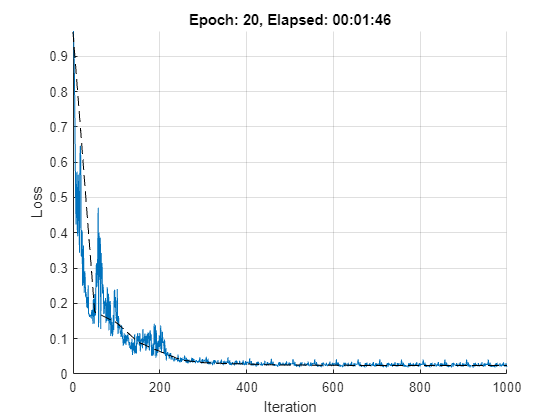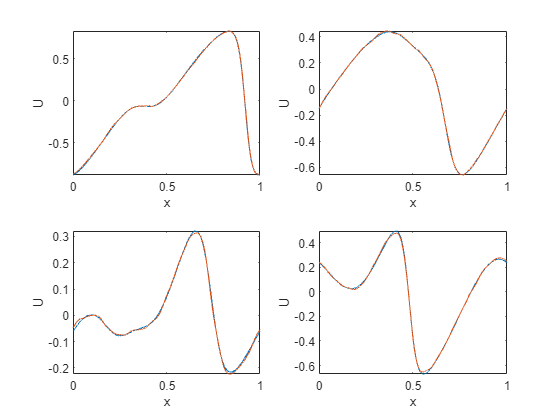The Fourier Neural Operator (FNO) [1] is a neural operator with an integral kernel parameterized in Fourier space. This allows for an expressive and efficient architecture. Applications of the FNO include weather forecasting and, more generically, finding efficient solutions to the Navier-Stokes equations which govern fluid flow.
Add fno directory to the path.
addpath(genpath('fno'));Requires:
- MATLAB (R2021b or newer)
- Deep Learning Toolbox™
[1] Zongyi Li, Nikola Kovachki, Kamyar Azizzadenesheli, Burigede Liu, Kaushik Bhattacharya, Andrew Stuart, and Anima Anandkumar. Fourier Neural Operator for Parametric Partial Differential Equations. In International Conference on Learning Representations (ICLR), 2021a. (https://openreview.net/forum?id=c8P9NQVtmnO)
In this example we apply the Fourier Neural Operator to learn the one-dimensional Burgers' equation with the following definition:
where and
is the Reynolds number. Periodic boundary conditions are imposed across the spatial domain. We learn the operator mapping the initial condition
to the solution at time
:
.
We use the burgers_data_R10.mat, which contains initial velocities and solutions
of the Burgers' equation. We then use these as training inputs and targets respectively. The network inputs include the spatial domain
at the desired discretization. In this example we choose a grid size of
.
% Setup.
addpath(genpath('fno'));
% Download training data.
dataDir = fullfile('data');
if ~isfolder(dataDir)
mkdir(dataDir);
end
dataFile = fullfile(dataDir,'burgers_data_R10.mat');
if ~exist(dataFile, 'file')
location = 'https://ssd.mathworks.com/supportfiles/nnet/data/burgers1d/burgers_data_R10.mat';
websave(dataFile, location);
end
data = load(dataFile, 'a', 'u');
x = data.a;
t = data.u;
% Specify the number of observations in training and test data, respectively.
numTrain = 1e3;
numTest = 1e2;
% Specify grid size and downsampling factor.
h = 2^10;
n = size(x,2);
ns = floor(n./h);
% Downsample the data for training.
xTrain = x(1:numTrain, 1:ns:n);
tTrain = t(1:numTrain, 1:ns:n);
xTest = x(end-numTest+1:end, 1:ns:n);
tTest = t(end-numTest+1:end, 1:ns:n);
% Define the grid over the spatial domain x.
xmax = 1;
xgrid = linspace(0, xmax, h);
% Combine initial velocities and spatial grid to create network
% predictors.
xTrain = cat(3, xTrain, repmat(xgrid, [numTrain 1]));
xTest = cat(3, xTest, repmat(xgrid, [numTest 1]));
Here we create a dlnetwork for the Burgers' equation problem. The network accepts inputs of dimension [h 2 miniBatchSize], and returns outputs of dimension [h 1 miniBatchSize]. The network consists os multiple blocks which combine spectral convolution with regular, linear convolution. The convolution in Fourier space filters out higher order oscillations in the solution, while the linear convolution learns local correlations.
numModes = 16;
width = 64;
lg = layerGraph([ ...
convolution1dLayer(1, width, Name='fc0')
spectralConvolution1dLayer(width, numModes, Name='specConv1')
additionLayer(2, Name='add1')
reluLayer(Name='relu1')
spectralConvolution1dLayer(width, numModes, Name='specConv2')
additionLayer(2, Name='add2')
reluLayer(Name='relu2')
spectralConvolution1dLayer(width, numModes, Name='specConv3')
additionLayer(2, Name='add3')
reluLayer(Name='relu3')
spectralConvolution1dLayer(width, numModes, Name='specConv4')
additionLayer(2, Name='add4')
convolution1dLayer(1, 128, Name='fc5')
reluLayer(Name='relu5')
convolution1dLayer(1, 1, Name='fc6')
]);
lg = addLayers(lg, convolution1dLayer(1, width, Name='fc1'));
lg = connectLayers(lg, 'fc0', 'fc1');
lg = connectLayers(lg, 'fc1', 'add1/in2');
lg = addLayers(lg, convolution1dLayer(1, width, Name='fc2'));
lg = connectLayers(lg, 'relu1', 'fc2');
lg = connectLayers(lg, 'fc2', 'add2/in2');
lg = addLayers(lg, convolution1dLayer(1, width, Name='fc3'));
lg = connectLayers(lg, 'relu2', 'fc3');
lg = connectLayers(lg, 'fc3', 'add3/in2');
lg = addLayers(lg, convolution1dLayer(1, width, Name='fc4'));
lg = connectLayers(lg, 'relu3', 'fc4');
lg = connectLayers(lg, 'fc4', 'add4/in2');
numInputChannels = 2;
XInit = dlarray(ones([h numInputChannels 1]), 'SCB');
net = dlnetwork(lg, XInit);
analyzeNetwork(net)
The network is trained using the standard SGDM algorithm, where the learn rate is decreased every stepSize iterations.
executionEnvironment = "gpu";
batchSize = 20;
learnRate = 1e-3;
momentum = 0.9;
numEpochs = 20;
stepSize = 100;
gamma = 0.5;
expNum = 1;
checkpoint = false;
expDir = sprintf( 'checkpoints/run%g', expNum );
if ~isfolder( expDir ) && checkpoint
mkdir(expDir)
end
vel = [];
totalIter = 0;
numTrain = size(xTrain,1);
numIterPerEpoch = floor(numTrain./batchSize);
Train the network.
if executionEnvironment == "gpu" && canUseGPU
xTrain = gpuArray(xTrain);
xTest = gpuArray(xTest);
end
start = tic;
figure;
clf
lineLossTrain = animatedline('Color', [0 0.4470 0.7410]);
lineLossTest = animatedline('Color', 'k', 'LineStyle', '--');
ylim([0 inf])
xlabel("Iteration")
ylabel("Loss")
grid on
% Compute initial validation loss.
y = net.predict( dlarray(xTest, 'BSC') );
yTest = extractdata(permute(stripdims(y), [3 1 2]));
relLossTest = relativeL2Loss(yTest , tTest);
addpoints(lineLossTest, 0, double(relLossTest/size(xTest,1)))
% Main loop.
lossfun = dlaccelerate(@modelLoss);
for epoch = 1:numEpochs
% Shuffle the data.
dataIdx = randperm(numTrain);
for iter = 1:numIterPerEpoch
% Get mini-batch data.
batchIdx = (1:batchSize) + (iter-1)*batchSize;
idx = dataIdx(batchIdx);
X = dlarray( xTrain(batchIdx, :, :), 'BSC' );
T = tTrain(batchIdx, :);
% Compute loss and gradients.
[loss, dnet] = dlfeval(lossfun, X, T, net);
% Update model parameters using SGDM update rule.
[net, vel] = sgdmupdate(net, dnet, vel, learnRate, momentum);
% Plot training progress.
totalIter = totalIter + 1;
D = duration(0,0,toc(start),'Format','hh:mm:ss');
addpoints(lineLossTrain,totalIter,double(extractdata(loss/batchSize)))
title("Epoch: " + epoch + ", Elapsed: " + string(D))
drawnow
% Learn rate scheduling.
if mod(totalIter, stepSize) == 0
learnRate = gamma.*learnRate;
end
end
% Compute validation loss and MSE.
y = net.predict( dlarray(xTest, 'BSC') );
yTest = extractdata(permute(stripdims(y), [3 1 2]));
relLossTest = relativeL2Loss( yTest , tTest );
mseTest = mean( (yTest(:) - tTest(:)).^2 );
% Display progress.
D = duration(0,0,toc(start),'Format','hh:mm:ss');
numTest = size(xTest, 1);
fprintf('Epoch = %g, train loss = %g, val loss = %g, val mse = %g, total time = %s. \n', ...
epoch, extractdata(loss)/batchSize, relLossTest/numTest, mseTest/numTest, string(D));
addpoints(lineLossTest, totalIter, double(relLossTest/numTest))
% Checkpoints.
if checkpoint
filename = sprintf('checkpoints/run%g/epoch%g.mat', expNum, epoch);
save(filename, 'net', 'epoch', 'vel', 'totalIter', 'relLossTest', 'mseTest', 'learnRate');
end
end
Epoch = 1, train loss = 0.226405, val loss = 0.175389, val mse = 7.73286e-05, total time = 00:00:13.
Epoch = 2, train loss = 0.153691, val loss = 0.145805, val mse = 5.99213e-05, total time = 00:00:22.
Epoch = 3, train loss = 0.0923258, val loss = 0.0904608, val mse = 2.49174e-05, total time = 00:00:27.
Epoch = 4, train loss = 0.102122, val loss = 0.0639219, val mse = 1.43723e-05, total time = 00:00:32.
Epoch = 5, train loss = 0.0346076, val loss = 0.0393621, val mse = 9.33419e-06, total time = 00:00:36.
Epoch = 6, train loss = 0.0361029, val loss = 0.032303, val mse = 7.10724e-06, total time = 00:00:45.
Epoch = 7, train loss = 0.0270364, val loss = 0.0296161, val mse = 6.43696e-06, total time = 00:00:50.
Epoch = 8, train loss = 0.0263171, val loss = 0.0283881, val mse = 5.92292e-06, total time = 00:00:54.
Epoch = 9, train loss = 0.0248211, val loss = 0.0261364, val mse = 5.54218e-06, total time = 00:00:58.
Epoch = 10, train loss = 0.0243392, val loss = 0.0253596, val mse = 5.32946e-06, total time = 00:01:03.
Epoch = 11, train loss = 0.0236119, val loss = 0.0250861, val mse = 5.22886e-06, total time = 00:01:07.
Epoch = 12, train loss = 0.023318, val loss = 0.024752, val mse = 5.12552e-06, total time = 00:01:11.
Epoch = 13, train loss = 0.0230901, val loss = 0.0243369, val mse = 5.04185e-06, total time = 00:01:16.
Epoch = 14, train loss = 0.0229644, val loss = 0.0241713, val mse = 4.99882e-06, total time = 00:01:20.
Epoch = 15, train loss = 0.0228391, val loss = 0.0240904, val mse = 4.99516e-06, total time = 00:01:25.
Epoch = 16, train loss = 0.022768, val loss = 0.0240143, val mse = 4.97173e-06, total time = 00:01:29.
Epoch = 17, train loss = 0.0228152, val loss = 0.023916, val mse = 4.95474e-06, total time = 00:01:33.
Epoch = 18, train loss = 0.022787, val loss = 0.0238792, val mse = 4.94643e-06, total time = 00:01:38.
Epoch = 19, train loss = 0.0227602, val loss = 0.023865, val mse = 4.93665e-06, total time = 00:01:42.
Epoch = 20, train loss = 0.0227464, val loss = 0.0238451, val mse = 4.93358e-06, total time = 00:01:46.
Here we take the trained network and test on unseen data with a higher spatial resolution than the training data. This is an example of zero-shot super-resolution.
gridHighRes = linspace(0, xmax, n);
idxToPlot = numTrain+(1:4);
figure;
for p = 1:4
xn = dlarray(cat(1, x(idxToPlot(p),:), gridHighRes),'CSB');
yn = predict(net, xn);
subplot(2, 2, p)
plot(gridHighRes, t(idxToPlot(p),:)), hold on, plot(gridHighRes, extractdata(yn))
axis tight
xlabel('x')
ylabel('U')
end
function [loss, grad] = modelLoss(x, t, net)
y = net.forward(x);
y = permute(stripdims(y), [3 1 2]);
y = stripdims(y);
loss = relativeL2Loss(y, t);
grad = dlgradient(loss, net.Learnables);
end
function loss = relativeL2Loss(y, t)
diffNorms = normFcn( (y - t) );
tNorms = normFcn( t );
loss = sum(diffNorms./tNorms, 1);
end
function n = normFcn(x)
n = sqrt( sum(x.^2, 2) );
end
Copyright 2022-2023 The MathWorks, Inc.


